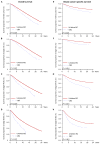Patterns of Occurrence and Outcomes of Contralateral Breast Cancer: Analysis of SEER Data
- PMID: 29857526
- PMCID: PMC6025574
- DOI: 10.3390/jcm7060133
Patterns of Occurrence and Outcomes of Contralateral Breast Cancer: Analysis of SEER Data
Abstract
Population-based estimates are lacking for the temporal trends in the contralateral breast cancer (CBC) risk for patients with breast cancer (BC). Data for BC patients diagnosed with CBC were collected from the Surveillance, Epidemiology, and End Results database. CBC incidence was calculated using the Kaplan-Meier method and the temporal trend in CBC incidence was assessed using joinpoint regression. Survival analysis was calculated using propensity scoring (PS) and multivariate Cox regression with a competing risk model. We found that 10,944 of 212,630 patients with early-stage BC were subsequently diagnosed with secondary BC in the contralateral breast. The 5-, 10-, 15-, and 20-year cumulative CBC incidences were 1.9, 4.6, 7.6, and 10.5%, respectively. Being younger (.
Keywords: SEER; contralateral breast cancer; incidence; outcome; propensity score.
Conflict of interest statement
All authors declare that they have no conflicts of interest.
Figures


References
-
- Lehman C.D., Gatsonis C., Kuhl C.K., Hendrick R.E., Pisano E.D., Hanna L., Peacock S., Smazal S.F., Maki D.D., Julian T.B., et al. MRI evaluation of the contralateral breast in women with recently diagnosed breast cancer. N. Engl. J. Med. 2007;356:1295–1303. doi: 10.1056/NEJMoa065447. - DOI - PubMed
-
- Rusner C., Wolf K., Bandemer-Greulich U., Engel J., Stegmaier C., Holleczek B., Schubert-Fritschle G., Tillack A., Stang A. Risk of contralateral second primary breast cancer according to hormone receptor status in Germany. Breast Cancer Res. 2014;16:452. doi: 10.1186/s13058-014-0452-4. - DOI - PMC - PubMed
LinkOut - more resources
Full Text Sources
Other Literature Sources

